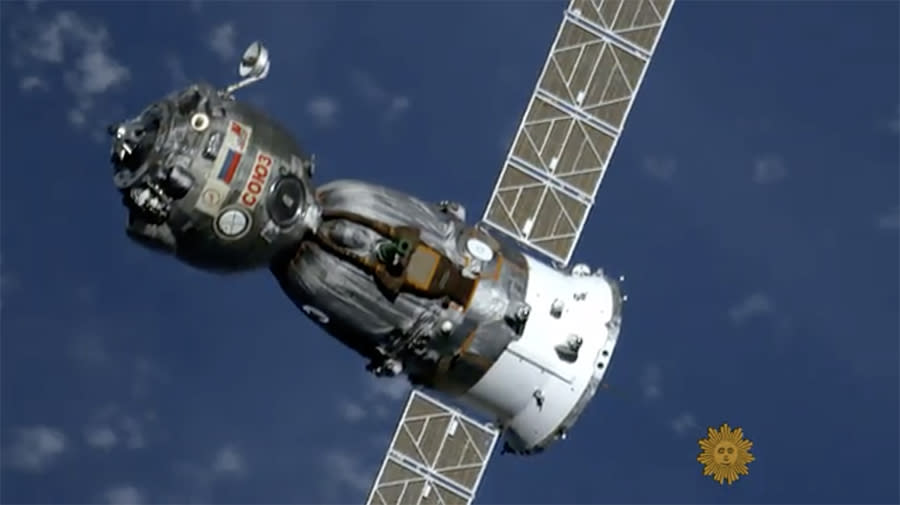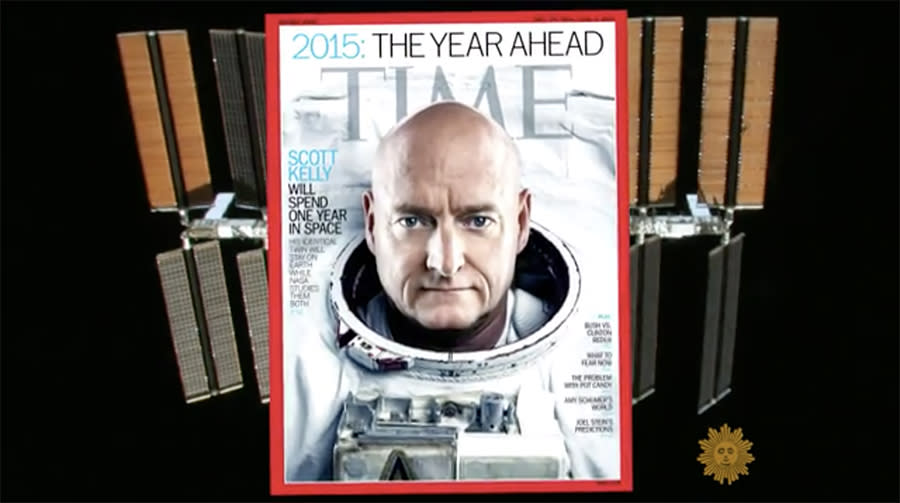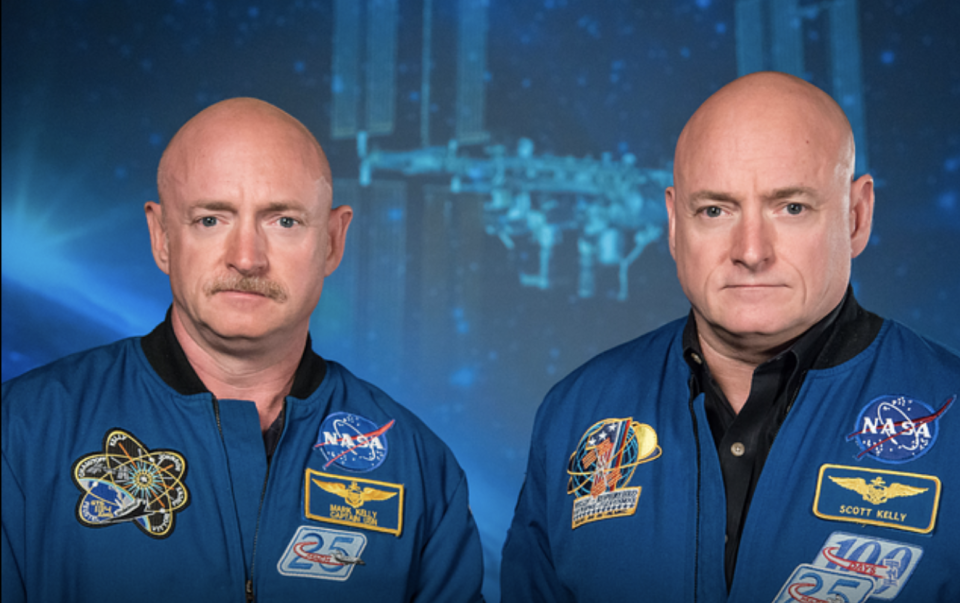After his year in space, astronaut Scott Kelly talks tech, rashes, and science deniers
A couple of years ago, I got one of the juiciest TV assignments ever: To interview NASA astronaut Scott Kelly, who was just about to lift off into space for a year aboard the International Space Station. That’s by far the longest any American has ever spent continuously in space. The idea was to study the effects of long-term zero-gravity living in space, in the name of preparing for a manned mission to Mars. (You can watch that CBS story here.)

Earlier, Kelly had already spent a six-month stint in space, and NASA already knew that bad things happen to you after awhile: you lose bone mass, you lose muscle, your immune system weakens, your eyesight suffers, and you get as much radiation each day as you’d get from 20 X-rays. Now, Kelly had more of that to look forward to. And remember: NASA stopped launching manned rockets in 2012 when it retired the Space Shuttle — so Kelly would ride to the Space Station aboard a Russian Soyuz rocket, which still uses decades-old technology.

“The good news is that it works — most of the time,” Kelly told me that day in 2015 as we climbed into a mockup of the tiny Soyuz capsule that would carry him into space. “They’ve had a couple accidents. But, you know, so have we, on the Space Shuttle. It’s risky. But you know, flying through space is a risky thing.”
Kelly made it to the Space Station safely, spent the year in space, conducted experiments, entertained thousands of people with a steady stream of tweets (and stunning photos) from space, and then made it back to Earth. (The Russians don’t splash down. Their capsule thuds down — on dry land.)

At the Consumer Electronics Show in Las Vegas a couple of weeks ago, I caught up with him again, the first time I’d had to chat with him since his return to Earth.
Tech in space
As a consumer tech guy, the first thing I wanted to know was how much gadgetry he had up in space. Did he have a phone?
“No, not like you’re thinking,” Kelly said. “We do have a capability to make calls, but it’s software on a laptop.” He had an iPad, but it couldn’t get online; if he wanted to send a text, he did it via email from his laptop.
“There’s some slow internet capability, kinda like dialup used to be,” he said. “I’ve bought stuff on Amazon. I bought airline tickets. We did some online banking with Chase.”
And, of course, he had cameras. “The cameras we use are almost exclusively Nikons —hence my being here for the CES at the Nikon booth.” (He used a Nikon D4.)
So, how did the year in space feel compared to his six-month gig? “It was a lot longer, clearly, but it felt a lot longer, too,” he says. “I mean, a year’s a long time to be in any one place.”
One of NASA’s goals was to compare his biological readings with his identical twin brother Mark (also a former NASA astronaut, and husband of former U.S. Representative Gabby Giffords). And sure enough, they found differences: “I’m smarter and more handsome than he is, they found,” Kelly cracks.

But seriously, folks…
“There were some changes in our gene expression, which was interesting to the scientists. Meaning, the genes inside of me were turning on and off much more rapidly than my brother’s on Earth. And gene turning on could be good, it could be bad — we don’t know. And they saw that my telomeres got better. Telomeres are things on the ends of your chromosomes, that are an indication of your physical age. It’s almost like I got a little bit younger. Clean living, I guess.”
Physical effects
Kelly also told me about the physical effects of returning to Earth after a year without gravity. It wasn’t pretty.
“The experience coming back was different than when I flew for six months,” Kelly says. “It was much more significant: soreness, muscle aches and joint pain, swelling in my legs when I would stand up — I could feel the blood rushing out of the top of my body, down into my legs, could see my leg swollen up.” For weeks after returning, his skin also exhibited rashes and hives wherever it came in contact with cloth — like clothing or bed sheets.
“I was fatigued, nauseous, dizzy — I mean, things that were much different after spending a year in space versus six months. So, at least for me, there’s symptomatically kind of a bend in the curve there somewhere between six and nine months where the negative effects seem to accelerate.” It took eight months, he says, before he felt normal again.
The anti-science movement
I couldn’t help asking Kelly about the weird anti-science wave that seems to be washing through America these days.
“I think about it a lot, actually,” he says. “It’s a dangerous place to be where you doubt scientists, and when you have our government questioning that 97% of scientists say that climate change is real. It’s something we need to be serious about. It’s going to have effects on our children and our grandchildren if we don’t do something about it. And then to have our country be the lone country that pulls out of the Paris climate accords!? We’re supposed to be the leader, you know? Not alone. It’s just crazy.”
Kelly says that sometimes, despite himself, he winds up in conversation with “the flat-Earth people,” who maintain that the Earth is not, in fact, round. “I think some of those folks don’t really believe the Earth is flat; they just do it as a goof,” he says. “And it’s fun for them. But the problem with that is, you’re discounting a pretty significant scientific fact that the Earth is round. And if you can call question into that fact, it’s much easier for people to believe that climate change is a hoax, too. It validates other conspiracy theories, which we don’t need to be doing. It’s just dangerous. We need to be the leader on science, not the guy sitting in the corner as the denier.”
“Endurance”
Kelly didn’t ask me to plug his new book, “Endurance: A Year in Space, a Lifetime of Discovery.” But after our interview, I downloaded it and dove in. Its chapters alternate between telling the story of his growing up as a poor, unmotivated and underachieving student, and the story of his year in space. It spent 10 weeks on the New York Times bestseller list.
It’s a fantastic read, especially the sections comparing NASA’s approach to space travel (by-the-book, careful, risk-averse) with Russia’s (fairly freewheeling by comparison). Whereas NASA keeps people three miles away from the launch pad, people teem all around the Soviet launch pad — some of them smoking — until just before takeoff. The Russians don’t bother with a countdown, either; when they’re ready, they just take off.
Finally, “on the space shuttle,” Kelly writes in the book, “I never knew whether I was really going to space that day until I felt the solid rocket boosters right under me; there were always more scrubs than launches. On Soyuz, there is no question. The Russians haven’t scrubbed a launch after the crew was strapped in since 1969.”
Next stops
So what’s next for Kelly? He’s no longer with NASA. For now, he’s writing books and making speaking appearances.
“I probably wouldn’t fly in space again,” he says. Or at least “probably not with NASA, but you never know. Somewhere else maybe.”
Dear SpaceX: Are you listening? Commander Kelly is ready to go.
David Pogue, tech columnist for Yahoo Finance, welcomes non-toxic comments in the Comments below. On the Web, he’s davidpogue.com. On Twitter, he’s @pogue. On email, he’s [email protected]. You can sign up to get his stuff by email, here.
Read more:
Exclusive: What Fitbit’s 6 billion nights of sleep data reveals about us
Tech that can help you keep your New Year’s resolutions
Pogue’s holiday picks: 8 cool, surprising tech gifts
Google’s Pixel Buds: Wireless earbuds for the extremely tolerant
Study finds you tend to break your old iPhone when a new one comes out
Rejoice: Sonos Speakers are finally voice-controllable
Follow Yahoo Finance on Facebook, Twitter, Instagram, and LinkedIn
